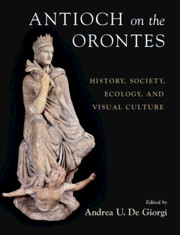Book contents
- Antioch on the Orontes
- Antioch on the Orontes
- Copyright page
- Dedication
- Contents
- Plates
- Figures
- Tables
- Contributors
- Abbreviations
- Antioch on the Orontes
- Part I Beginnings
- Part II The Making of a Capital
- Part III The People of Antioch
- Part IV Religion
- Part V Crises and Resilience
- Chapter 27 Earthquakes and State Response at Antioch
- Chapter 28 Disasters and Divine Wrath
- Chapter 29 Infectious Disease and Its Repercussions in Sixth-Century Antioch
- Chapter 30 Memory and the City
- Index
- Plate Section
- References
Chapter 28 - Disasters and Divine Wrath
Antioch in the Homilies and Histories of Late Antiquity
from Part V - Crises and Resilience
Published online by Cambridge University Press: aN Invalid Date NaN
- Antioch on the Orontes
- Antioch on the Orontes
- Copyright page
- Dedication
- Contents
- Plates
- Figures
- Tables
- Contributors
- Abbreviations
- Antioch on the Orontes
- Part I Beginnings
- Part II The Making of a Capital
- Part III The People of Antioch
- Part IV Religion
- Part V Crises and Resilience
- Chapter 27 Earthquakes and State Response at Antioch
- Chapter 28 Disasters and Divine Wrath
- Chapter 29 Infectious Disease and Its Repercussions in Sixth-Century Antioch
- Chapter 30 Memory and the City
- Index
- Plate Section
- References
Summary
This chapter explores intellectual responses to disasters and the creation and use of the disaster-divine wrath discourse as it spread from homilies to histories over time. It argues for centering human responses to disaster as the way forward using critical disaster theory.
Keywords
- Type
- Chapter
- Information
- Antioch on the OrontesHistory, Society, Ecology, and Visual Culture, pp. 451 - 463Publisher: Cambridge University PressPrint publication year: 2024



